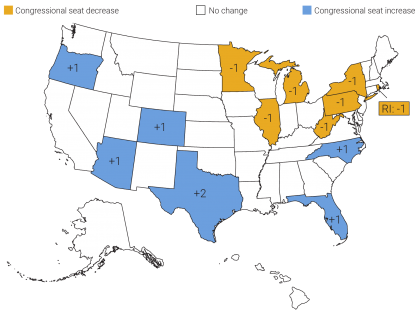Kelvin Pollard
Former Senior Demographer

February 19, 2020
Former Senior Demographer
Associate Vice President, U.S. Programs
The Census Bureau’s state-level population estimates for 2018 provide a window into the potential redistribution of seats in the U.S. House of Representatives when the 2020 Census numbers are released. Based on these 2018 population estimates, 13 states would see changes in their number of congressional seats (see figure). Not surprisingly, southern and western states would gain seats at the expense of states in the Northeast and Midwest.
Arizona, Colorado, Florida, North Carolina, and Oregon would each add one seat, while Texas would pick up two. Seven states would each lose a seat—Illinois, Michigan, Minnesota, New York, Pennsylvania, Rhode Island, and West Virginia.
Assuming the procedure remains unchanged from that in 2000 and 2010, the population totals used for congressional reapportionment will include not only the resident population of each state, but also the number of military and civilian employees of the U.S. government (plus their dependents) who are posted overseas.1 (The Census Bureau is changing the way it counts troops deployed overseas for 2020; a recent Federal Register notice provides more information.2) The new apportionment will be based on each state’s population count as of April 1, 2020; the official counts will remain unknown until the end of that year. However, 2020 projections indicate that reapportionment could affect additional states. For example, Montana could gain a seat while Alabama and Ohio could each lose one. Florida could gain a second seat, Texas could add a third, and New York could lose a second seat.3
Projected Congressional Reapportionment in 2020 Based on 2018 Estimates

Source: Election Data Services.
Even with the expected gains for the South and West, the 2020 apportionment numbers could surprise—as the 2010 numbers ultimately did. For example, apportionment projections based on 2009 population estimates had indicated that Florida would pick up a single seat and Texas would gain three, but each state added one more seat than had been anticipated. In addition, New York ended up losing two seats in 2010 (rather than just one as had been projected) and Missouri lost one. That state’s congressional representation had been expected to remain unchanged.4
The 2020 Census results will have a lasting impact on the distribution of seats in the House of Representatives, so it is critically important to have an accurate count of the population in each state. An undercount of the population in one state—or an overcount in another—could shift the balance of power in Congress for the next 10 years.
This article is excerpted from Mark Mather et al., “What the 2020 Census Will Tell Us About a Changing America,” Population Bulletin 74, no. 1 (2019).
